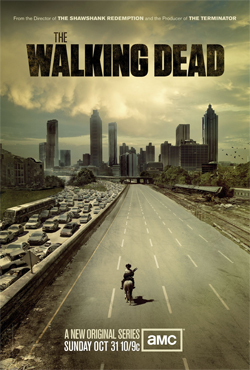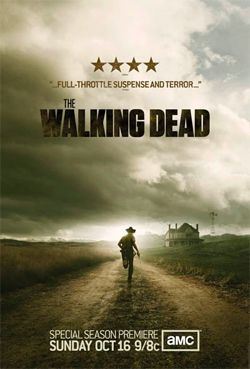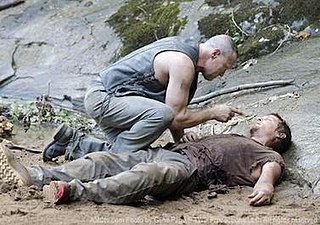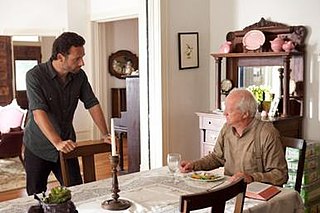
The first season of The Walking Dead, an American post-apocalyptic horror television series on AMC, premiered on October 31, 2010, and concluded on December 5, 2010, consisting of 6 episodes. Developed for television by Frank Darabont, who wrote or co-wrote four of the season's six episodes and directed the pilot episode, "Days Gone Bye", the series is based on the eponymous series of comic books by Robert Kirkman, Tony Moore, and Charlie Adlard. It was executive produced by Darabont, Kirkman, David Alpert, Charles H. Eglee, and Gale Anne Hurd, with Darabont assuming the role of showrunner.

The second season of The Walking Dead, an American post-apocalyptic horror television series on AMC, premiered on October 16, 2011, and concluded on March 18, 2012, consisting of 13 episodes. Developed for television by Frank Darabont, the series is based on the eponymous series of comic books by Robert Kirkman, Tony Moore, and Charlie Adlard. It was executive produced by Darabont, Kirkman, Glen Mazzara, David Alpert, and Gale Anne Hurd, with Mazzara assuming the role of showrunner after Darabont's departure from the series.

"Days Gone Bye" is the pilot episode of the post-apocalyptic horror television series The Walking Dead. It originally aired on AMC in the United States on October 31, 2010. The episode's teleplay was written and directed by Frank Darabont, the series creator.

"Vatos" is the fourth episode of the first season of the post-apocalyptic horror television series The Walking Dead. It originally aired on AMC in the United States on November 21, 2010. The episode was written by Robert Kirkman and directed by Johan Renck. In the episode, Rick Grimes, Daryl Dixon, Theodore "T-Dog" Douglas, and Glenn Rhee return to downtown Atlanta in search of Daryl's brother, Merle. The group are later targeted by a Latino gang, whose leader threatens to kill them if they do not relinquish their weapons. Meanwhile, Lori Grimes and Shane Walsh 's relationship begins to crumble.

"TS-19" is the sixth and final episode of the first season of the post-apocalyptic horror television series The Walking Dead. It originally aired on AMC in the United States on December 5, 2010. The episode was written by Adam Fierro and series creator Frank Darabont and directed by Guy Ferland. In the episode, the group finally finds safe haven in the Centers for Disease Control and Prevention (CDC) headquarters, although the only scientist there, Dr. Edwin Jenner hides many secrets that leads the group to demand answers about the zombie apocalypse.

"What Lies Ahead" is the second season premiere episode of the post-apocalyptic horror television series The Walking Dead. It originally aired on AMC in the United States on October 16, 2011. It was written by series developer Frank Darabont and series creator Robert Kirkman, and directed by Gwyneth Horder-Payton and Ernest Dickerson. In this episode, Rick Grimes leads his group toward Fort Benning, Georgia, but during an encounter with a horde of walkers, Sophia Peletier goes missing, and a search group is formed.

"Bloodletting" is the second episode of the second season of the post-apocalyptic horror television series The Walking Dead, and the 8th overall episode of the series. It initially aired on AMC in the United States on October 23, 2011. The episode was written by Glen Mazzara and directed by Ernest Dickerson. In this episode, Rick Grimes and Shane Walsh rush to save the life of Rick's son, Carl, and discover a possible safe haven in the process.

"Save the Last One" is the third episode of the second season of the post-apocalyptic horror television series The Walking Dead, and the 9th episode overall of the series. It first aired on AMC in the United States on October 30, 2011. The episode was written by Scott M. Gimple and directed by Phil Abraham. In the episode, Shane Walsh and Otis desperately attempt to flee the walker-infested high school in order to deliver supplies to a dying Carl Grimes. Meanwhile, Daryl Dixon and Andrea continue to search for Sophia Peletier.

The third season of The Walking Dead, an American post-apocalyptic horror television series on AMC, premiered on October 14, 2012, and concluded on March 31, 2013, consisting of 16 episodes. Developed for television by Frank Darabont, the series is based on the eponymous series of comic books by Robert Kirkman, Tony Moore, and Charlie Adlard. It was executive produced by Kirkman, Glen Mazzara, David Alpert, and Gale Anne Hurd, with Mazzara as showrunner for his second and final season. The third season was very well received by critics. It was nominated for multiple awards and won two, including Best Syndicated/Cable Television Series, at the 39th Saturn Awards.

"Cherokee Rose" is the fourth episode of the second season of the post-apocalyptic horror television series The Walking Dead, and the 10th overall episode of the series. Written by Evan Reilly and directed by Billy Gierhart, this episode, named after the Georgia state flower and a legendary symbol of the Trail of Tears, aired on AMC in the United States on November 6, 2011. The survivors are given a temporary sanctuary at the farm of Hershel Greene While the group contemplates what to do, Daryl Dixon continues to search for Sophia Peletier.

"Chupacabra" is the fifth episode of the second season of the post-apocalyptic horror television series The Walking Dead. It originally aired on AMC in the United States on November 13, 2011. In the episode, Daryl Dixon, delusional from being wounded in a search mission, desperately tries to return to the Greene farm. Meanwhile, Glenn unravels a secret that could endanger the survivors.

"Secrets" is the sixth episode of the second season of the post-apocalyptic horror television series The Walking Dead. It originally aired on AMC in the United States on November 20, 2011. In this episode, Glenn tells Dale Horvath that Lori Grimes is pregnant and there are numerous walkers in the Greene barn. Dale confronts Hershel Greene about hoarding walkers in his barn. Meanwhile, Shane Walsh attempts to teach Andrea how to use weapons and Lori agonizes over the decision to terminate her pregnancy or keep the baby.

"Pretty Much Dead Already" is the seventh episode and mid-season finale of the second season of the post-apocalyptic horror television series The Walking Dead. It originally aired on AMC in the United States on November 27, 2011. In the episode, Glenn reveals to the group that there are walkers in the Greenes' barn, dividing the group on what to do. Hershel Greene sets a deadline for the group to leave, unless Rick Grimes does a difficult task. Meanwhile, Shane Walsh slowly loses his sanity after many secrets around him are revealed and Carol Peletier begins to question whether her daughter, Sophia will be found.

"Triggerfinger" is the ninth episode of the second season of the post-apocalyptic horror television series The Walking Dead. It originally aired on AMC in the United States on February 19, 2012. The episode was written by David Leslie Johnson and was directed by Billy Gierhart. In the episode, Rick Grimes 's actions initiate a standoff between his group, Dave and Tony's men, and the walkers nearby. Meanwhile, Shane Walsh decides to save Lori Grimes, who has been injured in a car crash.

"18 Miles Out" is the tenth episode of the second season of the post-apocalyptic horror television series The Walking Dead. It originally aired on AMC in the United States on February 26, 2012. The episode was written by Scott M. Gimple and series showrunner Glen Mazzara and directed by Ernest Dickerson. In the episode, Rick Grimes and Shane Walsh debate Randall 's fate, leading to a physical battle between the two. Meanwhile, the survivors at the Greene farm deal with Beth Greene 's suicidal behavior. In addition, this episode foreshadows the revelation that people do not need to be bitten to turn into walkers when Rick and Shane find two walkers without any sign of bite marks on them, although Rick dismisses the importance of this discovery.

"Judge, Jury, Executioner" is the eleventh episode of the second season of the post-apocalyptic horror television series The Walking Dead. It originally aired on AMC in the United States on March 4, 2012. In this episode, Rick Grimes and his group opt to execute Randall, much to the frustration of Dale Horvath. Dale fears that the group is losing their humanity, which prompts him to persuade some of the group members to protest against the consensus. Meanwhile, Carl Grimes behaves recklessly and carelessly, going as far as to steal Daryl Dixon 's gun and harass a walker, which will ultimately initiate grave consequences for the group.

"Better Angels" is the twelfth and penultimate episode of the second season of the post-apocalyptic horror television series The Walking Dead, which aired on AMC in the United States and Canada on March 11, 2012.

"Beside the Dying Fire" is the 13th and final episode of the second season of the postapocalyptic horror television series The Walking Dead, which aired on AMC on March 18, 2012. The episode was written by creator Robert Kirkman and showrunner Glen Mazzara, and directed by series regular Ernest Dickerson. In the episode, a huge horde of walkers invades the Greene farm, chasing Rick Grimes and Hershel's groups off the premises. Meanwhile, Andrea is separated from the group, leaving her to fight off the same walkers that attacked Hershel's farm.

Lori Grimes is a fictional character from the comic book series The Walking Dead and was portrayed by Sarah Wayne Callies in the American television series of the same name. Created by writer Robert Kirkman and artist Tony Moore, the character made her debut in The Walking Dead #2 in 2003. In both forms of media, she is married to Rick Grimes. They have two children Carl and Judith. The character escapes the zombie apocalypse with Carl, and Rick's partner Shane Walsh. Believing her husband to be dead, she starts a relationship with Shane. But then she finds her husband is alive and breaks it off with Shane.

"Seed" is the third season premiere of the post-apocalyptic horror television series The Walking Dead, which aired on AMC in the United States and Canada on October 14, 2012. The episode was written by showrunner Glen Mazzara and directed by Ernest Dickerson.





















